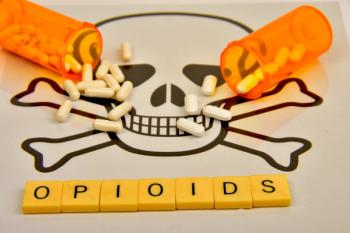
- Drug Topics August 2021
- Volume 165
- Issue 8
How to Tactfully Handle Naloxone Counseling
Naloxone education often requires difficult but necessary conversations with patients.
Pharmacists can save lives by counseling patients on naloxone use, although it may be a difficult topic to address. If you are not experienced in naloxone counseling, where do you begin? Drug Topics® interviewed experts on how to best approach patients about naloxone, an opioid antagonist medication that is used to reverse an opioid overdose.
Put Patients At Ease
Ellen R. Cohn, PhD, CCC-SLP, AASHA-F, who is an adjunct professor of communications at the University of Pittsburgh in Pennsylvania and an adjunct professor at the University of Maryland Global Campus, reminds pharmacists to maintain eye contact, convey caring, and be direct and calm. She suggests telling the patient: “The medication you are taking could put you at risk. It would be good to have an antidote on hand.” If the pharmacist is anxious about discussing this sensitive topic, the patient can pick up on their anxiety, she said. Cohn acknowledges that the topic may be difficult, but it will become second nature over time. “The more one delivers the message, the easier it will be,” she said.
Amanda McQuillan, PharmD, BCPS, BCPP, is a pharmacist in Pittsburgh. “You have to approach the subject like any other,” she said. “For example, does it make you feel awkward counseling a [patient with diabetes] on healthy food options or educating someone on an EpiPen? If you feel uncomfortable, they obviously will, too. Your anxiety about the topic will come across as being judgmental, and that never goes well when counseling a patient,” she said. In a situation where she thinks the patient may feel o ended, McQuillan reviews all the possible ways the patient can accidentally overdose, such as when starting a new medication or when they have an acute respiratory illness. She also asks if the patient has any children in their home who could come across the medication. “It’s really a public safety measure for everyone,” she said.
Rebecca Bouse, PharmD, pharmacy manager at Walmart Pharmacy in Newcastle, Oklahoma, approaches counseling with an “open mind and one of care to the patient and their family, [including] children and pets,” who may accidentally ingest the patient’s medication. After introducing herself, Bouse lets the patient know that she would like to discuss safe medication use and risk. “I also ask permission to speak openly and candidly. Empathy is key, and I place myself in their shoes and think about how difficult it must be to have to take opiate medication for their health condition,” she said. Bouse suggests listening with an open mind and letting the patient talk freely.
“There is already a stigma attached to opiates, and often patients feel judged [about their] treatment with opiate medications even before the conversation starts,” she said. Bouse then o ers to check the price of naloxone HCl nasal spray (Narcan; Emergent BioSolutions) with insurance or a discount card. Bouse and her colleagues document conversations in the patient profile. “We never force a patient to obtain Narcan. It’s always a choice. And more times than not, they opt out. It’s not a failure. It just may take several times or talking to various family members for the justification to make sense,” she said.
Elizabeth VanSlyke, PharmD, BCPS, begins naloxone counseling by saying, “We have an initiative to provide naloxone to any patient on opioids— no matter the dose—and this is a standard of care.” By starting this way, “I think this helps, so people don’t feel singled out,” she said. VanSlyke encourages the patient to bring their spouse or another close friend or family member for training. She finds that using the word “poisoning” is better accepted by patients than “overdose.” VanSlyke emphasizes that the risk of overdose or poisoning is present and possible. “I normally tell patients that typically the naloxone never gets used, [it] expires, and they dispose of it and get a new one, but it is a protective factor that we would much rather have in place and available on the small chance it is needed, versus needing it and not having it,” she said.
Tailor Counseling Points to the Patient
Crystal D. Choi, PharmD, MS, MEd, is a pharmacist at CVS in Las Vegas, Nevada. She reminds pharmacists that many patients who take opioids are older adults, so there could be polypharmacy and drug interactions. “Mix-ups are a distinct possibility. If the patient, or someone else, takes the opiate medication by accident, or maybe they double a dose because they forgot they already took it, having the naloxone gives them a layer of protection,” she explained. Choi also considers younger patients who have children in the home. “For those patients, I point out that if a child takes their medication, naloxone could prevent an accidental overdose.
This line of reasoning is effective for parents picking up prescriptions for teen and young adult children, as well,” she said. “I also bring up the potential for drug interactions... and remind them that having it in the home is just a precaution. I let them know that naloxone is like an EpiPen. They can use it to save another person who needs it if the situation arises.”
Communicate the Need
McQuillan compares naloxone to a fire extinguisher. “Nobody anticipates setting a fire, but if there is one, you defi - nitely want a fire extinguisher, you want to know where it is located and how to use it, and, naturally, you are also going to call for help by calling 911,” she explained. Bouse uses an open-ended style of questioning. She asks patients questions such as, “What risks do you think there are with taking opiate medications?” and “What are the risks associated with adding other medications that can have additive depressant effects or adding medications that have a stimulant effect?”
She acknowledges to the patient that all the various medications have a valid place in therapy. However, there are also risks associated with each treatment that can cause unexplained respiratory depression, up to and including sudden death in extreme cases. Bouse tries to avoid the word “overdose,” as most patients will automatically assume that it would never happen to them. She also compares taking opiates to driving a car— each has inherent risks. “Those risks go up with speeding, taking benzodiazepines, and so on,” she said.
Ensure Proper Use
When a patient gets naloxone, Choi takes it out of the box and shows the patient how to use it and where the directions are. She suggests that the patient teach other adults in the home.
“It’s just like CPR [cardiopulmonary resuscitation] or the EpiPen—a lifesaving measure—and they should be familiar with it before actually facing a situation where they have to use it,” Choi said. VanSlyke reminds patients to always carry naloxone, “just like an EpiPen, because if the naloxone is at home and the patient is not and something happens, it isn’t going to [do] any good.” VanSlyke also tells patients that more than 1 dose of naloxone may be needed. And if the patient regains consciousness, caregivers should stay with the patient until help arrives—do not cancel the ambulance.
Articles in this issue
over 4 years ago
Expanding Access Takes Telepharmacy to the Next Levelover 4 years ago
Exploring the Efficacy, Safety of Rotavirus Vaccinesover 4 years ago
New Prodrug for ADHD in School-aged Childrenover 4 years ago
Flu Season is Approaching, but Experts Don't Know What to Expectover 4 years ago
OTC and Prescription Products Can Relieve Psoriasisover 4 years ago
FDA Grants Priority Review to Tezepelumab for Severe Asthmaover 4 years ago
2021 Good Neighbor Pharmacy of the Year Finalist SpotlightNewsletter
Pharmacy practice is always changing. Stay ahead of the curve with the Drug Topics newsletter and get the latest drug information, industry trends, and patient care tips.





























































































































